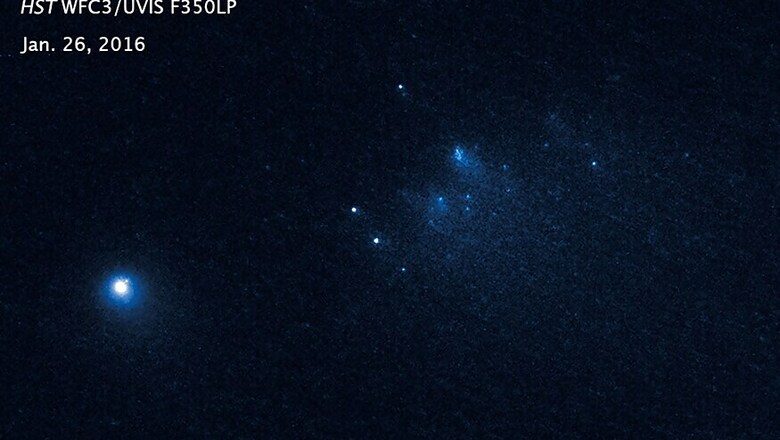
views
New York: Using NASA's Hubble space telescope, astronomers have captured the sharpest, most detailed observations of a comet breaking apart 108 million kilometres from Earth.
In a series of images taken over three days in January 2016, Hubble showed 25 fragments consisting of a mixture of ice and dust that are drifting away from the comet at a pace equivalent to the walking speed of an adult, said lead researcher David Jewitt from University of California, Los Angeles.
The images suggest that the roughly 4.5-billion-year-old comet, named 332P/Ikeya-Murakami, or comet 332P, may be spinning so fast that material is ejected from its surface.
The resulting debris is now scattered along a 4,828-km-long trail, said the study published online in Astrophysical Journal Letters.
 This animation, made from a sequence of Hubble Space Telescope images, shows the slow migration of building-size fragments of Comet 332P/Ikeya-Murakami over a three-day period in January 2016. The pieces broke off of the main nucleus in late 2015 as the icy, ancient comet approached the sun in its orbit.
This animation, made from a sequence of Hubble Space Telescope images, shows the slow migration of building-size fragments of Comet 332P/Ikeya-Murakami over a three-day period in January 2016. The pieces broke off of the main nucleus in late 2015 as the icy, ancient comet approached the sun in its orbit.
Credits: NASA, ESA, D. Jewitt (UCLA)
These observations provide insight into the volatile behaviour of comets as they approach the sun and begin to vaporise, unleashing powerful forces.
"We know that comets sometimes disintegrate, but we don't know much about why or how," Jewitt said.
"The trouble is that it happens quickly and without warning, so we don't have much chance to get useful data. With Hubble's fantastic resolution, not only do we see really tiny, faint bits of the comet, but we can watch them change from day to day. That has allowed us to make the best measurements ever obtained on such an object," Jewitt noted.
The three-day observations show that the comet shards brighten and dim as icy patches on their surfaces rotate into and out of sunlight.
Their shapes change, too, as they break apart. The icy relics comprise about four percent of the parent comet and range in size from roughly 65 feet wide to 200 feet wide.
They are separating at only a few kilometres per hour as they orbit the sun at more than 80,467 kms per hour.
The Hubble images show that the parent comet changes brightness frequently, completing a rotation every two to four hours. A visitor to the comet would see the sun rise and set in as little as an hour, Jewitt said.
The comet is much smaller than astronomers thought, measuring only 1,600 feet across, about the length of five football fields.
Comet 332P was discovered in November 2010, after it surged in brightness and was spotted by two Japanese astronomers.




















Comments
0 comment